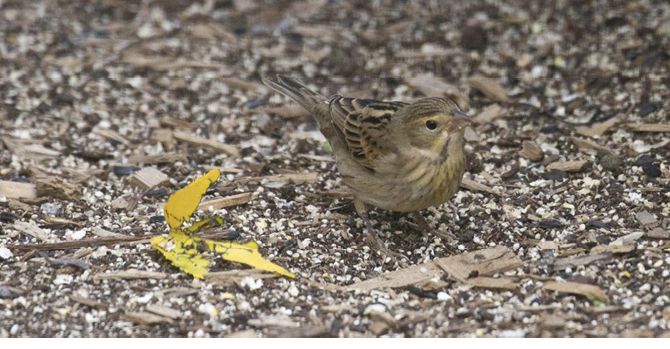
CARL GOODRICH
December is a month when many birds regularly begin coming to backyard bird feeders, so it is a good season to keep a sharp eye on your feeders. It is also the season when unexpected visitors may occasionally appear among the more regular feeder clientele. With this in mind, a careful look at the background in this issue’s mystery photograph shows the mystery bird on the ground and surrounded by bird seed—a good clue that the bird was photographed at a feeder.
Although the mystery bird can be identified from the black and white magazine photograph, the printed image is darker than might be desirable, so readers are encouraged to also view the online photograph for a brighter color image. Upon examining the image, it is easy to see that the large pale bill of the mystery species is conical and shaped like that of a finch or a sparrow. In addition, the bird has a fairly broad supercilium over and extending well beyond the eye. The online color image also shows a trace of light yellow on the finely streaked breast and a hint of rusty color on the median wing coverts.
The mystery bird bears a superficial resemblance to a female House Sparrow, especially the back pattern, which has at least one bold buffy brace visible in the photograph. However, the bird also has prominent malar streaks and rusty wing coverts, as well as a finely streaked breast and crown—both of which are a solid dingy gray brown in a female House Sparrow. These features eliminate this otherwise similar-looking bird from the abundant and familiar House Sparrow. Regardless of the superficial resemblance of the mystery species to a female House Sparrow, its streaked breast with its wash of yellow should by itself remove the House Sparrow as an identification candidate and clinch the mystery species as an immature female Dickcissel (Spiza americana).
The Dickcissel is a rare spring visitor in Massachusetts and an uncommon fall migrant, appearing in thickets and weedy fields near the coast from late August through early November. Dickcissels also frequently show up at bird feeders in winter, where they can easily be overlooked among flocks of House Sparrows.
Carl Goodrich photographed this Dickcissel at his feeder in Eastham, Barnstable County, October 14, 2020.
Wayne R. Petersen